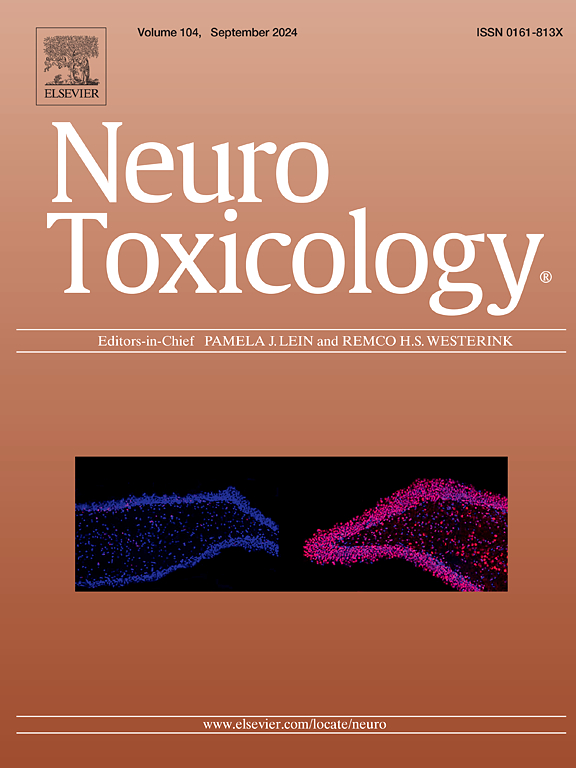Acute, prolonged, and chronic exposure to organochlorine insecticides evoke differential effects on in vitro neuronal activity and network development
IF 3.9
3区 医学
Q2 NEUROSCIENCES
引用次数: 0
Abstract
Organochlorine insecticide exposure has been associated with neurodevelopmental and neurodegenerative disorders. Moreover, both in vitro and in vivo studies have shown that exposure to organochlorine insecticides causes hyperactivity in the nervous system, and negatively affects calcium homeostasis, neurite outgrowth, and neurotransmitter (receptor) levels. Some of the in vivo effects and associations from epidemiological studies were sex-specific, highlighting the importance of investigating the effects of organochlorine exposure in both sexes. It is therefore of great importance to investigate the effects of prolonged, developmental exposure to organochlorines on the development of neuronal network activity. Here, we examined the effects of acute (30 min), prolonged (up to 48 h), and chronic (21 days) exposure to DDT, its metabolite DDE, endosulfan, dieldrin, and lindane on neuronal activity and network development in sex-separated rat primary cortical cultures using micro-electrode array (MEA) recordings. Our study showed that acute exposure to all tested organochlorines evoked a hyperexcitation, sometimes at concentrations ≤ 1 µM. Exposure to DDT, DDE, endosulfan, and dieldrin inhibited neuronal activity after prolonged exposure, while exposure to lindane had no clear effects after 24 and 48 h. Chronic exposure to all tested organochlorines inhibited neuronal network development at high micromolar concentrations. Most of these effects were observed at non-cytotoxic concentrations, except for exposure to 100 µM endosulfan. Some of the effects found in this study differed between male and female cultures, but no clear sex-specific patterns could be determined across exposure scenarios or between compounds. Together, these results show that acute, prolonged, and chronic exposure to organochlorine insecticides evoke differential effects on neuronal activity and network development. The effects found after acute exposure to DDT, endosulfan, dieldrin, and lindane occur at concentrations close to, or even below human internal exposure levels, highlighting the importance of further monitoring human exposure to organochlorine insecticides.
急性、长期和慢性暴露于有机氯杀虫剂对体外神经元活动和网络发育的不同影响
有机氯杀虫剂暴露与神经发育和神经退行性疾病有关。此外,体外和体内研究都表明,暴露于有机氯杀虫剂会导致神经系统过度活跃,并对钙稳态、神经突生长和神经递质(受体)水平产生负面影响。流行病学研究的一些体内影响和关联是性别特异性的,突出了调查两性接触有机氯的影响的重要性。因此,研究长期发育暴露于有机氯对神经网络活动发育的影响具有重要意义。在这里,我们使用微电极阵列(MEA)记录检测了急性(30 min)、长期(长达48 h)和慢性(21天)暴露于DDT及其代谢物DDE、硫丹、狄氏剂和林丹对性别分离大鼠原代皮层培养物神经元活动和网络发育的影响。我们的研究表明,急性暴露于所有测试的有机氯会引起过度兴奋,有时浓度≤ 1 µM。暴露于DDT、DDE、硫丹和狄氏剂后,长时间暴露可抑制神经元活动,而暴露于林丹后,24和48 h后无明显影响。长期暴露于所有测试的有机氯在高微摩尔浓度下抑制神经网络发育。除了暴露于100 µM硫丹外,大多数这些影响在非细胞毒性浓度下观察到。在这项研究中发现的一些影响在男性和女性文化中有所不同,但没有明确的性别特异性模式可以确定在不同的暴露场景或化合物之间。总之,这些结果表明,急性、长期和慢性暴露于有机氯杀虫剂会对神经元活动和网络发育产生不同的影响。急性暴露于滴滴涕、硫丹、狄氏剂和林丹后所发现的影响,其浓度接近甚至低于人体内部暴露水平,这突出了进一步监测人体暴露于有机氯杀虫剂的重要性。
本文章由计算机程序翻译,如有差异,请以英文原文为准。
求助全文
约1分钟内获得全文
求助全文
来源期刊

Neurotoxicology
医学-毒理学
CiteScore
6.80
自引率
5.90%
发文量
161
审稿时长
70 days
期刊介绍:
NeuroToxicology specializes in publishing the best peer-reviewed original research papers dealing with the effects of toxic substances on the nervous system of humans and experimental animals of all ages. The Journal emphasizes papers dealing with the neurotoxic effects of environmentally significant chemical hazards, manufactured drugs and naturally occurring compounds.
 求助内容:
求助内容: 应助结果提醒方式:
应助结果提醒方式:


